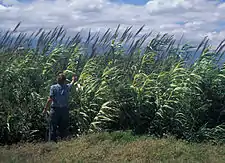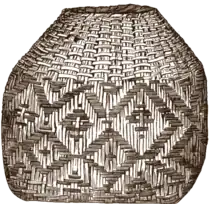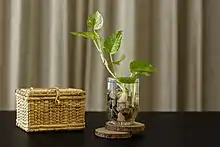Cane (grass)
Cane is any of various tall, perennial grasses with flexible, woody stalks, and more specifically from the genus Arundinaria.[1]

Scientifically speaking, there are either of two genera from the family Poaceae. The genus Arundo is native from the Mediterranean Basin to the Far East. The genus Arundinaria is a bamboo (Bambuseae) found in the New World. Neither genus includes sugarcane (genus Saccharum, tribe Andropogoneae).
Cane commonly grows in large riparian stands known as canebrakes, found in toponyms throughout the Southern and Western United States; they are much like the tules (Schoenoplectus acutus) of California.
Depending on strength, cane can be fashioned for various purposes, including walking sticks, crutches, assistive canes or judicial or school canes. Where canes are used in corporal punishment, they must meet particular specifications, such as a high degree of flexibility. Cane historically has been used for many other purposes such as baskets, furniture, boats, roofs and wherever stiff, withy sticks can be put to good use.
Etymology
The English word cane derives from Old French cane 'sugarcane', from Latin canna, from Ancient Greek κάννα, from Official Aramaic qanhā, qanyā and from Akkadian qanû 'tube, reed'.
Other uses

Cane is used for a variety of artistic and practical purposes, such as Native American baskets of North America. During the 18th and early 19th century, non-commissioned officers in some European armies could carry canes to discipline troops (when not in use, the cane was hooked to a cross-belt or a button). Cane is used to describe furniture made of wicker. Cane also describes a length of colored, patterned glass rod used in caneworking, a style of glassblowing.
Canes are used in regional folk-dancing and as props on stage. For example, folk-dancers may twirl canes overhead, stand them on the head, spin them off to the sides, or strike them on the floor.[2]

External links
| Wikimedia Commons has media related to Arundo. |
| Wikisource has the text of the 1911 Encyclopædia Britannica article Cane. |
- Germplasm Resources Information Network: Arundo
- Erowid Arundo Donax vault
- Fashionable Walking Canes & Walking Sticks — History of Canes Page Info (reprinted with permission)
- Description of Arundinaria
- Walking-Stick Papers (Robert Cortes Holliday, 1918) — Project Gutenberg ebook
- Modern cane fighting based on Oriental techniques
- Reprinted early 1900s information about the Vigny cane and associated techniques
